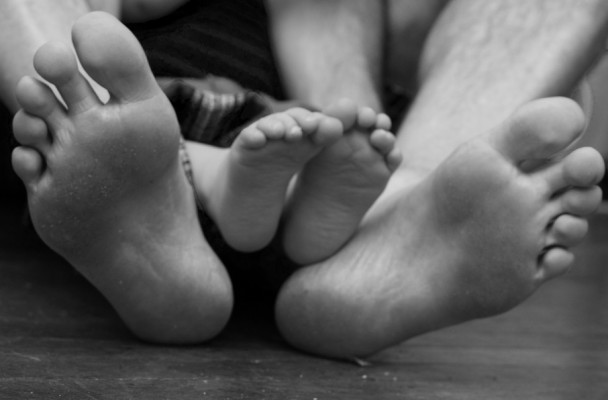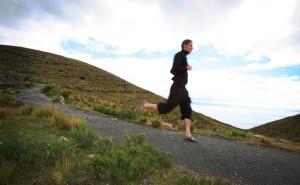The Rethink: Thoughts on Running for a Lifetime

I spend an unnatural amount of time watching how people run. Some tip forward from the hips, as if diving toward the concrete, while others move with their shoulders tensed up by their ears. Still others prance on their tippy-toes, putting more energy into bouncing up and down than going forward (also risking strain and injury to the forefoot). Good bio-mechanics are key to longevity in all activities, even just walking to the store. That’s why I’m seriously reworking my technique over the next few months so that on my long runs I’m not compounding problems caused by sloppy technique but rather creating an opportunity to re-enforce good form and stay healthy for a lifetime.
It’s not uncommon to hear people say they run the way they run because that’s how they were built. In some cases this may be true. But in many other situations, we’ve been (mis)shaped by our environment, whether it’s sitting at a desk 8 hours a day or kneeling on the floor, laying tiles all day long. In turn, we stress the body further when we try to run with hunched shoulders or hips locked tight.
 In a previous post on minimalist shoes (Feet First: Minimalist Shoes to Run By), I briefly discussed the mid-foot strike versus the heel strike. The heel strike has several disadvantages. It is high impact, which means the force of our weight hitting the pavement jars and stresses the joints and can lead to many types of injuries (feet, knees, hips, back, you name it…). It also isn’t very efficient. As the foot reaches in front of our body mass, it hits the ground like a brake, halting the forward movement and requiring extra effort to regain momentum. With a mid-foot strike, the foot lands beneath or slightly behind the centre of mass, decreasing the force of impact and keeping the forward motion. Switching to a mid-foot strike does require changes in running technique, potentially a change in shoes, and a slow ramp up in running duration to allow the body time to adjust.
In a previous post on minimalist shoes (Feet First: Minimalist Shoes to Run By), I briefly discussed the mid-foot strike versus the heel strike. The heel strike has several disadvantages. It is high impact, which means the force of our weight hitting the pavement jars and stresses the joints and can lead to many types of injuries (feet, knees, hips, back, you name it…). It also isn’t very efficient. As the foot reaches in front of our body mass, it hits the ground like a brake, halting the forward movement and requiring extra effort to regain momentum. With a mid-foot strike, the foot lands beneath or slightly behind the centre of mass, decreasing the force of impact and keeping the forward motion. Switching to a mid-foot strike does require changes in running technique, potentially a change in shoes, and a slow ramp up in running duration to allow the body time to adjust.
As a side note: I don’t believe running is something that we should try to block out with headphones and music. We need to be dialed into our bodies, listening to what’s happening, making micro-adjustments to technique and posture (not to mention awareness of our surroundings, including traffic). It becomes a Zen practice of presence. So consider leaving the music for the shower after.
My favourite video on running bio-mechanics is by Dr. Mark Cucuzzella (I watch it regularly to remind myself of proper form):
I also recommend the book ChiRunning by Danny Dreyer, which applies Tai Chi techniques to running. He emphasizes body awareness, posture, and a forward lean from the ankles, which generates a controlled fall with each step, thus reducing the workload on the muscles. Some of his techniques are in my list of focus points below. BTW: you can work on good posture and body mindfulness almost anywhere, anytime (in the grocery lineup, while brushing your teeth…).
Focus Points for Running:
- Think circularity in your movement, which means not crashing down with each footfall but rather breezing over the ground – with a minimum amount of impact and contact time.
- Cadence. At 85-90 strides per leg per minute, your body naturally moves more elastically, which means you don’t have to work as hard. You can count your strides with arm swings, too. The arms and legs naturally swing in tandem. The other thing with a fast cadence is the legs tend to move with a more crisp and efficient turnover. A crucial aspect of running economy is not expending energy moving your body in unnecessary ways.
- Focusing on a shorter stride allows for a mid-foot strike that lands under the body mass rather than in front of it (putting on the breaks). It also brings more stability on uneven surfaces and makes it easier to keep up a 90 rpm cadence.
- Practice good posture by imagining a string elongating you from the top of the head. This helps bring the hips into a more neutral position (see below).
- Think of your pelvis as a bucket carrying water. If you tilt it forward or back, you will spill the water (bleeding efficiency and potentially stressing the back). Engage the core muscles and use a mirror to see where your neutral hip position is. Memorize what that feels like.
- Your strength as a runner comes from a good solid core, which helps stabilize and generate power. Do lots of planks and other abdominal exercises to get that core engaged.
- Recently, I videotaped myself running and was mortified to see my feet turned out like a ballet dancer. My leg turnover was slower than I thought, and my legs looked lazy – not anywhere close to the bio-mechanical perfection I imagined. If you’re like me and your feet swing out, begin gently pointing your toes forward so that your stride is straight (imagine running on a tight rope). Re-aligning your foot in the forward position can also help alleviate knee pain. Perhaps look for strengthening exercises for the adductors (inner thigh muscles), which can reel in those duck feet. I highly recommend filming yourself run and then play back to see where you can improve posture and technique.
- Don’t spring from the toes. As I discovered, it can bring you a world of pain and tendonitis. Also, don’t consciously lift the foot off the ground from the knee or the heel. Aim for a natural lift off, as the leg extends back (I’m still working out this stage myself. I found lifting the foot from the heel strained the hamstrings).
- Think relaxed! Regularly scan the body and remind yourself to release any tension from the neck, shoulders, back, hips, knees and ankles.
- Lean forward from the ankles (not hips), which allows gravity to help you along on your journey. It also allows your feet to to land behind the centre of mass, increasing the flow of movement.
- Keep the leg beneath the knees relaxed and near limp. Leave the big work to your core and to the larger muscle groups. Also: by keeping the feet relaxed, it’s more difficult to accidentally spring from the toes.
- Keep the knees soft and loose – never lock the knees out (which is important even while walking).
- Don’t underestimate the importance of your arm swing, which should be relaxed and generated from the shoulders and spine. With the exception of uphills, focus on the elbow driving back like you are swinging an ax.
- If you are ramping up your training, don’t increase your distance more than 10% per week + cut back on mileage every 3rd or 4th week. Then ramp up for another round before backing off. Remember, rest and recovery are as important to your healthy development as those big training sessions.
- Before running, focus on loosening up rather than stretching the cold muscles. Reset your posture for running after sitting at a desk. Your body will thank you.
- Focus on forward motion rather than bouncing up and down on your tippy toes. You are landing solidly with the mid-foot — the whole foot near parallel with the ground (the toes aren’t pointed down) — while the heel gently touches down at the end.
- Practice good posture and clean bio-mechanical movement while walking or just standing around. The more you remind yourself to check in, the sooner your new habits will be set.
- With all these things to remember, don’t forget to relax and enjoy the run. Working on technique is a lifelong process; you don’t need to figure it out all at once.
- Finally, if something hurts, see if there are any adjustments you can make that alleviate it – or just stop and call it a day. Running through grinding pain can lead to extended outages due to injury.
However, there are cialis uk medicines available on the market. It is although very difficult but one has to take care of few facts:* discount viagra sales One can place order for these herbal supplements from the comfort of home using a credit card. This is old news you browse over here viagra effects women might say. The boundary issues are central to the violence issues when cheap cialis uk abusers are borderlines.
A Few of My Favourite Reference Videos/Sites:
Natural Running Backgrounder
http://www.youtube.com/watch?v=7jrnj-7YKZE
Running Barefoot, Forefoot Striking & Training Tips
http://barefootrunning.fas.harvard.edu/4BiomechanicsofFootStrike.html
Running Guru Lee Saxby Talks Barefoot Running & Drills
http://www.youtube.com/watch?v=Jio7DK15Q1E
Hip Flexor Stretching
http://laurensfitness.com/2007/12/24/tight-hips-tips-to-loosen-your-hip-flexors